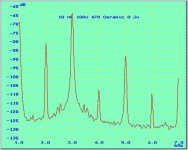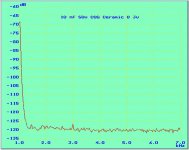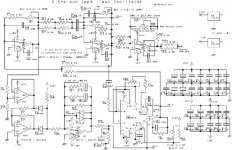Nada, they are same thing. And its NP0 and C0G, not NPO or COGAndrewT said:Hi all,
what is the difference between NPO and COG ceramic capacitors?
How might it affect their intended end use?
"Negative-Positive-Zero" as tempco is +-30ppm
C0G capacitors have excellent dielectric characteristics which compete with better film varieties: low distortion, low DA, low DF. X5R capacitors, and its siblings, are another matter entirely having dielectric characteristics that compete with the worst of electrolytics for Worst Capacitor Ever.
Seeing as I mentioned the dreaded X5R, here's a distortion plot of an X7R. Says Cyril Bateman who performed the test generating the plot:
"This 10nF X7R ceramic was made by a CECC approved, European manufacturer. It was tested at 1kHz and 3 volts, in series with a 10k ohm current limiting resistor. Measurable distortion exists at all voltages down to 0.5 volts – my lowest test voltage."
"This 10nF X7R ceramic was made by a CECC approved, European manufacturer. It was tested at 1kHz and 3 volts, in series with a 10k ohm current limiting resistor. Measurable distortion exists at all voltages down to 0.5 volts – my lowest test voltage."
Attachments
Hi Tom,
Thanks for the plots. Do you have the test configuration diagram?
Too bad ceramics a got a bad rap in the audio world. They are really good performers if used properly. But can a nightmare if misused. (piezo microphonics). I still use em X7R included and could not be without.
Generally use for low imp/supply bypass. Never in high imp/ high gain circuits like feedback networks. NP0's abound in RF world up to several GHz.
Thanks for the plots. Do you have the test configuration diagram?
Too bad ceramics a got a bad rap in the audio world. They are really good performers if used properly. But can a nightmare if misused. (piezo microphonics). I still use em X7R included and could not be without.
Generally use for low imp/supply bypass. Never in high imp/ high gain circuits like feedback networks. NP0's abound in RF world up to several GHz.
Hi AndrewT,
C0G and NP0 you will find at
http://en.wikipedia.org/wiki/NP0
This are class I dielectrics.
Class II mats are are also in the wiki:
http://en.wikipedia.org/wiki/EIA_Class_2_dielectric
Class II dielectrics have a high Epsilon and less linearity. This may be a main reason for their distortions in signal lines.
Regards
Onra
C0G and NP0 you will find at
http://en.wikipedia.org/wiki/NP0
This are class I dielectrics.
Class II mats are are also in the wiki:
http://en.wikipedia.org/wiki/EIA_Class_2_dielectric
Class II dielectrics have a high Epsilon and less linearity. This may be a main reason for their distortions in signal lines.
Regards
Onra
Yikes that'll break my eyeballs. Way too much detail. Couldn't even find the DUT. Would it be possible to draw something highly simplified? do it have DC bias with resistor impedance? AC generator levels/imp @1KHz, spectrum analzer used, etc
Alternatively if it's really a bother links on the web for tests like these that are handy. sorry this is interesting for me.
Alternatively if it's really a bother links on the web for tests like these that are handy. sorry this is interesting for me.
infinia said:
Alternatively if it's really a bother links on the web for tests like these that are handy. sorry this is interesting for me.
See if you can get "Electronics World" at your hands in library or whatever, C. Bateman had something like 12-part article spread over one year issues about capacitor distortion and its causes.
You can do sub-ppm distortion measurements relatively easily with ultra-low distortion oscillator, passive notch filter and mid-level PC soundcard equipped with FFT software. But first you need super-quality caps wich are polypropylene extended metal foil (not metallized film)
Cyril Bateman used to sell a CD-rom full of his articles on caps (and many more). Send me an email and I'll send him your contact, I think he'll then contact you. Sorry for the procedure, but he had huge problems with his spammed email box and it is preferable to make contacts with him a bit complex.
For his sub-1ppm distortion test I built, I am looking for a freeware handy spectrum analyser using a PC-sound card. Any idea ?
For his sub-1ppm distortion test I built, I am looking for a freeware handy spectrum analyser using a PC-sound card. Any idea ?
28euros for Audiotester is not that bad.forr said:
For his sub-1ppm distortion test I built, I am looking for a freeware handy spectrum analyser using a PC-sound card. Any idea ?
Very low as distorition measurements show.AndrewT said:Any response to cap variation with voltage for this type? ppm/V? [/B]
Mzzj,Forr,
Thank you for your kind suggestions. I will check my puplic/uni library for the WW publications when I go. I think it is important for the test diagram/conditions to be included with plots/test data when the information is to be analyzed correctly.
Praxis v2.14 in time domain has been used by others on this forum. FYI All PC SpAnalyzers use FFT in function.
For PC SA see the following link I found.
http://www3.ocn.ne.jp/~hanbei/eng-winanalyzer.html
Thank you for your kind suggestions. I will check my puplic/uni library for the WW publications when I go. I think it is important for the test diagram/conditions to be included with plots/test data when the information is to be analyzed correctly.
Praxis v2.14 in time domain has been used by others on this forum. FYI All PC SpAnalyzers use FFT in function.
For PC SA see the following link I found.
http://www3.ocn.ne.jp/~hanbei/eng-winanalyzer.html
free sw
RMAA -RightMark Audio Analyzer is popular, not very flexible
Audacity project at Sourceforge will help you grab/create/edit .wavs
Scilab (just checked, Scilab.org website is down over this weekend) has wav import and I think I've seen a useful looking analysis package in thier reference page - free matlab work alike has many of the heavy duty matlab toolboxes for signal analysis
Cyril's circuitry isn't the best for the application - considerable simplification can be had with indirect nonlinearity measurements of IM differences - no need to build a low distortion oscillator, better recent 24 bit sound cards can also add ~ 20 dB resolution vs his setup - esi juli@, emu 1212m are < us$200
RMAA -RightMark Audio Analyzer is popular, not very flexible
Audacity project at Sourceforge will help you grab/create/edit .wavs
Scilab (just checked, Scilab.org website is down over this weekend) has wav import and I think I've seen a useful looking analysis package in thier reference page - free matlab work alike has many of the heavy duty matlab toolboxes for signal analysis
Cyril's circuitry isn't the best for the application - considerable simplification can be had with indirect nonlinearity measurements of IM differences - no need to build a low distortion oscillator, better recent 24 bit sound cards can also add ~ 20 dB resolution vs his setup - esi juli@, emu 1212m are < us$200
- Status
- This old topic is closed. If you want to reopen this topic, contact a moderator using the "Report Post" button.
- Home
- Design & Build
- Parts
- ceramic capacitors ?


